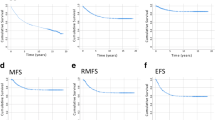Abstract
In the time-to-event setting, the concordance probability assesses the relative level of agreement between a model-based risk score and the survival time of a patient. While it provides a measure of discrimination over the entire follow-up period of a study, the probability does not provide information on the longitudinal durability of a baseline risk score. It is possible that a baseline risk model is able to segregate short-term from long-term survivors but unable to maintain its discriminatory strength later in the follow-up period. As a consequence, this would motivate clinicians to re-evaluate the risk score longitudinally. This longitudinal re-evaluation may not, however, be feasible in many scenarios since a single baseline evaluation may be the only data collectible due to treatment or other clinical or ethical reasons. In these scenarios, an attenuation of the discriminatory power of the patient risk score over time would indicate decreased clinical utility and call into question whether this score should remain a prognostic tool at later time points. Working within the concordance probability paradigm, we propose a method to address this clinical scenario and evaluate the discriminatory power of a baseline derived risk score over time. The methodology is illustrated with two examples: a baseline risk score in colorectal cancer defined at the time of tumor resection, and for circulating tumor cells in metastatic prostate cancer.





Similar content being viewed by others
References
Blanche P, Kattan MW, Gerds TA (2019) The c-index is not proper for the evaluation of \(t\)-year predicted risks. Biostatistics 20(2):347–357
Gerds TA, Kattan MW, Schumacher M, Yu C (2013) Estimating a time-dependent concordance index for survival prediction models with covariate dependent censoring. Stat Med 32(13):2173–2184
Gönen M, Heller G (2005) Concordance probability and discriminatory power in proportional hazards regression. Biometrika 92(4):965–970
Grambsch PM, Therneau TM (1994) Proportional hazards tests and diagnostics based on weighted residuals. Biometrika 81(3):515–526
Harrell FE, Lee KL, Mark DB (1996) Multi-variable prognostic models: Issues in developing models, evaluating assumptions and adequacy, and measuring and reducing errors. Stat Med 15:361–387
Heagerty PJ, Zheng Y (2005) Survival model predictive accuracy and ROC curves. Biometrics 61(1):92–105
Heller G, Mo Q (2016) Estimating the concordance probability in a survival analysis with a discrete number of risk groups. Lifetime Data Anal 22(2):263–279
Heller G, Fizazi K, McCormack RT, Molina A, MacLean D, Webb IJ, Saad F, de Bono JS, Scher HI (2017) The added value of circulating tumor cell enumeration to standard markers in assessing prognosis in a metastatic castration-resistant prostate cancer population. Clin Cancer Res 23(8):1967–1973
Parast L, Cai T (2013) Landmark risk prediction of residual life for breast cancer survival. Stat Med 10(32):3459–3471
Pencina MJ, D’Agostino RB (2004) Overall C as a measure of discrimination in survival analysis: model specific population value and confidence interval estimation. Stat Med 23((13)):2109–2123
Scher HI, Jia X, de Bono JS, Fleisher M, Pienta KJ, Raghavan D, Heller G (2009) Circulating tumor cells as prognostic markers in progressive, castration-resistant prostate cancer: a reanalysis of IMMC38 trial data. Lancet Oncol 10(3):233–239
Uno H, Cai T, Pencina MJ, D’Agostino RB, Wei LJ (2011) On the C-statistics for evaluating overall adequacy of risk prediction procedures with censored survival data. Stat Med 30((10)):1105–1117
Van Houwelingen HC (2007) Dynamic prediction by landmarking in event history analysis. Scand J Stat 34(1):70–85
Xu R, O’Quigley J (2000) Proportional hazards estimate of the conditional survival function. J R Stat Soc Ser B Methodol 62:667–680
Zhang Y, Shao Y (2018) Concordance measure and discriminatory accuracy in transformation cure models. Biostatistics 19(1):14–26
Acknowledgements
This work was supported by NIH Grants P30CA008748 and R01CA207220.
Author information
Authors and Affiliations
Corresponding author
Additional information
Publisher's Note
Springer Nature remains neutral with regard to jurisdictional claims in published maps and institutional affiliations.
Electronic supplementary material
Below is the link to the electronic supplementary material.
Rights and permissions
About this article
Cite this article
Devlin, S.M., Gönen, M. & Heller, G. Measuring the temporal prognostic utility of a baseline risk score. Lifetime Data Anal 26, 856–871 (2020). https://doi.org/10.1007/s10985-020-09503-3
Received:
Accepted:
Published:
Issue Date:
DOI: https://doi.org/10.1007/s10985-020-09503-3




